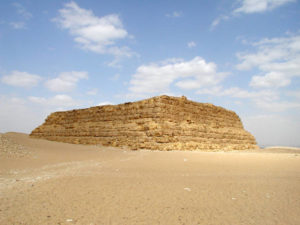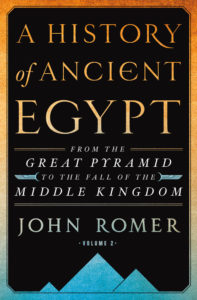by John Romer
For the majority of Westerners, the grand tour of Egypt had started in the 1870s when Thomas Cook & Sons obtained a concession from the Khedive Ismail to run Nile steamboats and dahabiyyas – luxurious sailing boats – from Cairo up to Aswan and into northern Nubia. Isolated on the quiet wide river, Cook’s tourists were afforded intimate views into the very heart of rural Upper Egypt. And as the boats moved gently on the stream, these privileged travelers could also spot the doors of ancient rock-cut tomb chapels, lines of shadowed rectangles standing over screes of bright white limestone chip set high up in the gilded cliffs that framed the riverside’s fields.

For Cook’s tourists, the cliff-cut tombs promised exciting and bumpy rides on carriages and donkeys along the muddy edges of the fields and out onto the little hot deserts that lay beneath the limestone cliffs, before scrambling up pathways in the loose scree and entering the cool gloom of tomb chapels whose stained and broken walls were covered in scenes showing agricultural activities similar to those they had observed in life, from the promenades of their floating hotels.
For archaeologists, those same tomb chapels indicated that there had been a substantial ancient settlement in the area; one with craftsmen and copper enough to support the making of such courtly monuments and to equip the ancient burials, which might still lay undisturbed beneath the tomb chapels, at the bottom of rock-cut shafts.
More than a thousand decorated tomb chapels are known to have survived from the age of the Old Kingdom, of which some 600 are still standing. Al most a third of that number are provincial tombs and were excavated in the limestone of the Nile-side cliffs.
most a third of that number are provincial tombs and were excavated in the limestone of the Nile-side cliffs.
Even as the craftsmen of the court were decorating the temples of Abusir with elegant scenes of country life, some contemporary courtiers were casting their eyes over rural landscapes that their forefathers had long since abandoned for Memphis and a life at court.
An early and influential solution to the growing shortage of space within the Giza cemeteries had been to excavate the bedrock underneath one of the great stone mastabas of Khufu’s queens, and then to fashion an entrance doorway that led to two rock-cut rooms beyond: one holding an offering chapel, the other a burial shaft. In the following decades, this simple scheme was extended so that other doorways resembling that of a mastaba’s offering chapel were cut into the walls of the nearby stone quarries, and the same two-room plan was excavated in the rock beyond.
These are the first-known rock-cut tombs in Egypt, and their design was adopted by the provincial courtiers so that the lines of their doorways – rectangles of shadow marked with white screes of chippings beneath them from the tombs’ excavation – came to punctuate whole sections of that narrow landscape.
JOHN ROMER has worked in Egypt since 1966 on archaeological digs in many key sites, including the Valley of the King and Karnak. He led the Brooklyn Museum expedition to excavate the tomb of Ramasses XI. He wrote and presented a number of television series, including The Seven Wonders of the World, Romer’s Egypt, Ancient Lives, and Testament. He lives in Tuscany, Italy.
